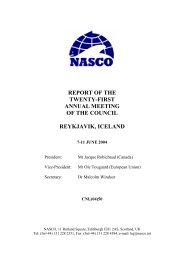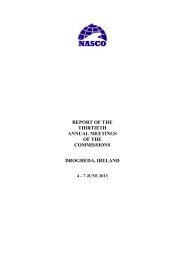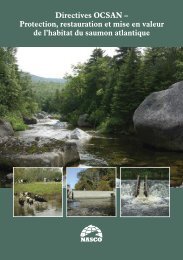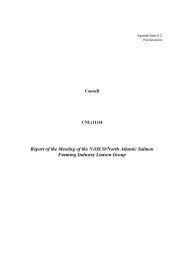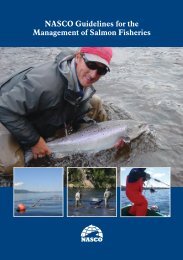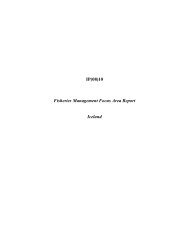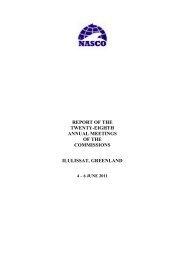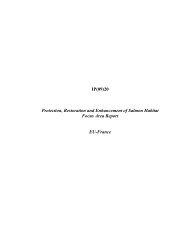Report of the 2005 ICES/NASCO Symposium on Interactions ...
Report of the 2005 ICES/NASCO Symposium on Interactions ...
Report of the 2005 ICES/NASCO Symposium on Interactions ...
Create successful ePaper yourself
Turn your PDF publications into a flip-book with our unique Google optimized e-Paper software.
NINA SPECIAL REPORT 34<br />
Annex 4: Disease and Parasite<br />
Iinteracti<strong>on</strong>s and <str<strong>on</strong>g>the</str<strong>on</strong>g>ir<br />
Management - Sessi<strong>on</strong><br />
Chairmen’s Summary<br />
Malcolm Beveridge and Chris Poupard<br />
Fifteen papers <strong>on</strong> <str<strong>on</strong>g>the</str<strong>on</strong>g> two broad <str<strong>on</strong>g>the</str<strong>on</strong>g>mes <str<strong>on</strong>g>of</str<strong>on</strong>g> science and<br />
management <str<strong>on</strong>g>of</str<strong>on</strong>g> disease and parasite interacti<strong>on</strong>s were<br />
presented, n<strong>on</strong>e <str<strong>on</strong>g>of</str<strong>on</strong>g> <str<strong>on</strong>g>the</str<strong>on</strong>g>m c<strong>on</strong>sidering species o<str<strong>on</strong>g>the</str<strong>on</strong>g>r than<br />
Atlantic salm<strong>on</strong> and sea trout.<br />
R<strong>on</strong> Stagg opened <str<strong>on</strong>g>the</str<strong>on</strong>g> sessi<strong>on</strong> with a broad-ranging<br />
presentati<strong>on</strong> that dealt with micro- and macro-parasites, in<br />
essence covering <str<strong>on</strong>g>the</str<strong>on</strong>g> entire gamut <str<strong>on</strong>g>of</str<strong>on</strong>g> Atlantic salm<strong>on</strong><br />
disease agents, from viruses and bacteria to ectoparasites.<br />
The paper examined some <str<strong>on</strong>g>of</str<strong>on</strong>g> <str<strong>on</strong>g>the</str<strong>on</strong>g> more important<br />
diseases that have appeared in salm<strong>on</strong> farms in Scotland<br />
since <str<strong>on</strong>g>the</str<strong>on</strong>g> incepti<strong>on</strong> <str<strong>on</strong>g>of</str<strong>on</strong>g> <str<strong>on</strong>g>the</str<strong>on</strong>g> industry and in so doing<br />
c<strong>on</strong>cluded that while originating in wild populati<strong>on</strong>s, <str<strong>on</strong>g>the</str<strong>on</strong>g><br />
emergence <str<strong>on</strong>g>of</str<strong>on</strong>g> parasitic infestati<strong>on</strong>s am<strong>on</strong>g farmed fish,<br />
sometimes with increasing associated virulence, is an<br />
inevitable c<strong>on</strong>sequence <str<strong>on</strong>g>of</str<strong>on</strong>g> farming. Much <str<strong>on</strong>g>of</str<strong>on</strong>g> <str<strong>on</strong>g>the</str<strong>on</strong>g><br />
presentati<strong>on</strong> focused <strong>on</strong> epidemics, exploring <str<strong>on</strong>g>the</str<strong>on</strong>g> insights<br />
being gained through <str<strong>on</strong>g>the</str<strong>on</strong>g> use <str<strong>on</strong>g>of</str<strong>on</strong>g> new types <str<strong>on</strong>g>of</str<strong>on</strong>g><br />
ma<str<strong>on</strong>g>the</str<strong>on</strong>g>matical modelling tools. The paper pointed out <str<strong>on</strong>g>the</str<strong>on</strong>g><br />
key differences between micro- and macro-parasite<br />
epidemics. It c<strong>on</strong>cluded that epidemics am<strong>on</strong>g farmed<br />
populati<strong>on</strong>s do not necessarily result in epidemics am<strong>on</strong>g<br />
wild fish populati<strong>on</strong>s, stressing <str<strong>on</strong>g>the</str<strong>on</strong>g> importance <str<strong>on</strong>g>of</str<strong>on</strong>g> good<br />
bio-security and husbandry in mitigating risk.<br />
Sea lice, and Lepeoph<str<strong>on</strong>g>the</str<strong>on</strong>g>irus salm<strong>on</strong>is ra<str<strong>on</strong>g>the</str<strong>on</strong>g>r than Caligus<br />
el<strong>on</strong>gatus, were menti<strong>on</strong>ed in R<strong>on</strong> Stagg’s presentati<strong>on</strong> and<br />
indeed dominated much <str<strong>on</strong>g>of</str<strong>on</strong>g> <str<strong>on</strong>g>the</str<strong>on</strong>g> rest <str<strong>on</strong>g>of</str<strong>on</strong>g> <str<strong>on</strong>g>the</str<strong>on</strong>g> day’s<br />
presentati<strong>on</strong>s and discussi<strong>on</strong>s. Karin Boxaspen reviewed<br />
what we know about <str<strong>on</strong>g>the</str<strong>on</strong>g> biology and genetics <str<strong>on</strong>g>of</str<strong>on</strong>g> <str<strong>on</strong>g>the</str<strong>on</strong>g><br />
parasite, focusing <strong>on</strong> recent research <strong>on</strong> life history,<br />
especially <str<strong>on</strong>g>the</str<strong>on</strong>g> impacts <str<strong>on</strong>g>of</str<strong>on</strong>g> temperature and salinity <strong>on</strong><br />
developmental rates, <strong>on</strong> behaviour and dispersi<strong>on</strong>. She<br />
reviewed new informati<strong>on</strong> <strong>on</strong> natural distributi<strong>on</strong> and<br />
advances in <str<strong>on</strong>g>the</str<strong>on</strong>g> applicati<strong>on</strong> <str<strong>on</strong>g>of</str<strong>on</strong>g> genetic techniques to<br />
understand parasite populati<strong>on</strong> structure and genetic<br />
diversity. The new discoveries are being applied to refine<br />
pest management strategies and to assess risks to wild fish<br />
populati<strong>on</strong>s. Molecular genetics work raises <str<strong>on</strong>g>the</str<strong>on</strong>g> possibility<br />
<str<strong>on</strong>g>of</str<strong>on</strong>g> a vaccine being developed against <str<strong>on</strong>g>the</str<strong>on</strong>g> parasite.<br />
A series <str<strong>on</strong>g>of</str<strong>on</strong>g> presentati<strong>on</strong>s explored <str<strong>on</strong>g>the</str<strong>on</strong>g> <str<strong>on</strong>g>the</str<strong>on</strong>g>me <str<strong>on</strong>g>of</str<strong>on</strong>g> wildfarmed<br />
fish pathogen interacti<strong>on</strong>s. Neil Haz<strong>on</strong> reported<br />
56<br />
<strong>on</strong> how sea lice infestati<strong>on</strong> affected <str<strong>on</strong>g>the</str<strong>on</strong>g> physiology <str<strong>on</strong>g>of</str<strong>on</strong>g> wild<br />
sea trout. In a series <str<strong>on</strong>g>of</str<strong>on</strong>g> laboratory trials, <str<strong>on</strong>g>the</str<strong>on</strong>g> threshold<br />
levels <str<strong>on</strong>g>of</str<strong>on</strong>g> infestati<strong>on</strong> at which physiological stress and<br />
osmoregulatory problems occur were determined. A<br />
threshold level <str<strong>on</strong>g>of</str<strong>on</strong>g> infestati<strong>on</strong> at which mortality am<strong>on</strong>g sea<br />
trout smolts was likely to occur was determined to be 13<br />
lice per fish. The susceptibility <str<strong>on</strong>g>of</str<strong>on</strong>g> wild, farmed and wildfarmed<br />
hybrid Atlantic salm<strong>on</strong> to sea lice and to Infectious<br />
Salm<strong>on</strong> Anaemia (ISA) and furunculosis was explored by<br />
Kevin Glover. No differences am<strong>on</strong>g fish treatment<br />
groups were found for furunculosis or ISA, and <str<strong>on</strong>g>the</str<strong>on</strong>g><br />
differences apparent in exposure to sea lice disappeared<br />
when differences in body size am<strong>on</strong>g treatment groups<br />
were taken into account. In c<strong>on</strong>clusi<strong>on</strong>, while<br />
domesticati<strong>on</strong> to date does not seem to have led to any<br />
systematic divergence in disease resistance from wild<br />
salm<strong>on</strong>, future selecti<strong>on</strong> programmes may.<br />
The paper presented by Bengt Finstad summarized<br />
present knowledge <str<strong>on</strong>g>of</str<strong>on</strong>g> interacti<strong>on</strong>s between lice <strong>on</strong><br />
farmed and wild salm<strong>on</strong>ids, drawing <strong>on</strong> much m<strong>on</strong>itoring<br />
data from Scotland, Ireland and Norway. Key points from<br />
<str<strong>on</strong>g>the</str<strong>on</strong>g> presentati<strong>on</strong> included <str<strong>on</strong>g>the</str<strong>on</strong>g> high infecti<strong>on</strong> pressure<br />
imposed by farms <strong>on</strong> wild stocks in many areas and <str<strong>on</strong>g>the</str<strong>on</strong>g><br />
inverse relati<strong>on</strong>ships between incidence <str<strong>on</strong>g>of</str<strong>on</strong>g> lice <strong>on</strong> wild sea<br />
trout and distance from fish farms.<br />
In determining <str<strong>on</strong>g>the</str<strong>on</strong>g> infecti<strong>on</strong> pressures that sea lice <strong>on</strong><br />
farmed fish pose for wild salm<strong>on</strong>ids it is important to<br />
understand sea lice dispersal and <str<strong>on</strong>g>the</str<strong>on</strong>g> behaviour <str<strong>on</strong>g>of</str<strong>on</strong>g> wild<br />
salm<strong>on</strong>ids that makes <str<strong>on</strong>g>the</str<strong>on</strong>g>m susceptible to infestati<strong>on</strong>. Two<br />
papers provided us with insights. Michael Penst<strong>on</strong><br />
presented two years <str<strong>on</strong>g>of</str<strong>on</strong>g> plankt<strong>on</strong> survey data from Loch<br />
Shieldaig in Northwest Scotland. Higher nauplii densities<br />
were found at sample sites close to farms while<br />
copepodid levels were highest at sites away from farms.<br />
Dispersal <str<strong>on</strong>g>of</str<strong>on</strong>g> copepodids was shown to be largely<br />
explained by wind-driven currents; by c<strong>on</strong>trast, nauplii<br />
were found throughout <str<strong>on</strong>g>the</str<strong>on</strong>g> top 5 m. Generalised<br />
Additive Models were used to analyse <str<strong>on</strong>g>the</str<strong>on</strong>g> pattern <str<strong>on</strong>g>of</str<strong>on</strong>g><br />
plankt<strong>on</strong>ic lice abundance, which showed an increase from<br />
stocking <str<strong>on</strong>g>of</str<strong>on</strong>g> farmed fish throughout <str<strong>on</strong>g>the</str<strong>on</strong>g> producti<strong>on</strong> cycle,<br />
followed by a marked decrease when fallowing began<br />
again.<br />
Peter Andreas Heuch looked at <str<strong>on</strong>g>the</str<strong>on</strong>g> effects <str<strong>on</strong>g>of</str<strong>on</strong>g> both<br />
hydrography and infecti<strong>on</strong> pressure <strong>on</strong> infecti<strong>on</strong> rate <str<strong>on</strong>g>of</str<strong>on</strong>g><br />
Atlantic salm<strong>on</strong> and sea trout smolts emigrating from <str<strong>on</strong>g>the</str<strong>on</strong>g><br />
two c<strong>on</strong>trasting fjord systems. These studies illustrated<br />
not <strong>on</strong>ly differences between areas in terms <str<strong>on</strong>g>of</str<strong>on</strong>g> infecti<strong>on</strong><br />
pressure, but also that within a system year-to-year



